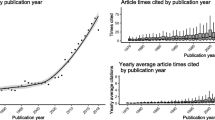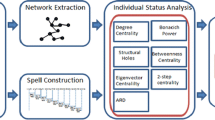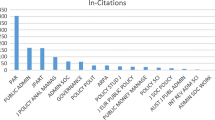Abstract
This study builds the interdisciplinary knowledge network of China, which is used to catch the knowledge exchange structure of disciplines, and investigates the evolution process from 1981 to 2010. A network analysis was performed to examine the special structure and we compare state of the networks in different periods to determine how the network has got such properties. The dataset are get from the reference relationship in literature on important Chinese academic journals from 1980 to 2010. The analytical results reveal the hidden network structure of interdisciplinary knowledge flows in China and demonstrate that the network is highly connected and has a homogeneous link structure and heterogeneous weight distribution. Through comparing of the network in three periods, that is 1981–1990, 1991–2000 and 2001–2010, we find that the special evolution process, which is limited by the number of nodes, play an important influence on interdisciplinary knowledge flows.










Similar content being viewed by others
References
Albert, R., & Barabási, A. L. (2002). Statistical mechanics of complex networks. Reviews of Modern Physics, 74, 47–97.
Barabási, A. L., Jeong, H., & Néda, Z. (2002). Evolution of the social network of scientific collaborations. Physica A: Statistical Mechanics and its Applications, 311, 590–614.
Barabási, A. L., & Albert, R. (1999). Emergence of scaling in random networks. Science, 286, 509–512.
Bassecoulard, E., Lelu, A., & Zitt, M. (2007). Mapping nanosciences by citation flows: A preliminary analysis. Scientometrics, 70(3), 859–880.
Cummings, J. N., & Kiesler, S. (2005). Collaborative research across disciplinary and organizational boundaries. Social Studies of Science, 35(5), 703–722.
Erdös, P., & Renyi, A. (1984). On the evolution of random graphs. Transactions of American Mathematical Society, 286(1), 17–61.
Fleming, L., & Frenken, K. (2007). The evolution of inventor networks in the silicon valley and Boston regions. Advances in Complex Systems, 10, 53–71.
Garfield, E. (1955). Citation indexes for science: A new dimension in documentation through association of ideas. Science, 122(3159), 108–111.
Guang, Y., Ming-Yang, W., & Da-Ren, Y. (2010). Characterizing knowledge diffusion of nanoscience & nanotechnology by citation analysis. Scientometrics, 84(1), 81–97.
Guimera, R., & Sales-Pardo, M. (2009). Missing and spurious interactions and the reconstruction of complex networks. PNAS, 106(52), 22073–22078.
Haythornthwaite, C. (2005). Knowledge flow in interdisciplinary teams. In Proceedings of the 38th Hawaii International Conference on System Sciences, Hawaii.
Huutoniemi, K., Klein, J. T., & Bruun, H. (2010). Analyzing interdisciplinarity: Typology and indicators. Research Policy, 39, 79–88.
Klein, J. T. (1990). Interdisciplinarity: History theory, and practice. Detroit: Wayne State University Press.
Klein, J. T. (2006). Afterword: the emergent literature on interdisciplinary and transdisciplinary research evaluation. Research Evaluation, 15(1), 75–80.
Klein, J. T. (2008). Evaluation of interdisciplinary and transdisciplinary research: A literature review. American Journal of Preventive Medicine, 35(2s), s116–s123.
Newman, M. E. J. (2001a). Scientific collaboration networks. I. Network construction and fundamental results. Physical Review E, 64(1), 016131.
Newman, M. E. J. (2001b). Scientific collaboration networks. II. Shortest paths, weighted networks, and centrality. Physical Review E, 64(1), 016132.
Newman, M. E. J. (2003). The structure and function of complex networks. SIMA Review, 45(2), 167–256.
Ortega, J. L., & Aguillo, I. F. (2010). Shaping the European research collaboration in the 6th Framework Programme health thematic area through network analysis. Scientometrics, 85(1), 377–386.
Price, D. J. S. (1965). Networks of scientific papers. Science, 149, 510–515.
Redner, S. (1998). How popular is your paper? An empirical study of the citation distribution. The European Physical Journal B, 4, 131–134.
Ronda-Pupo, G. A., & Guerras-Martin, L. A. (2010). Dynamics of the scientific community network within the strategic management field through the Strategic Management Journal. Scientometrics, 85(3), 821–848.
Sorenson, O., Rivkin, J. W., & Fleming, L. (2006). Complexity, networks and knowledge flow. Research Policy, 35, 994–1017.
Tomassini, M., & Luthi, L. (2007). Empirical analysis of the evolution of a scientific collaboration network. Physica A Statistical Mechanics and Its Applications, 385, 750–764.
Watts, D. J., & Strogatz, S. H. (1998). Collective dynamics of “small-world” networks. Nature, 393(6684), 440–442.
Yang, H. Y., Park, H. W., & Heo, J. (2010). A network analysis of interdisciplinary research relationships: The Korean government’s R&D grant program. Scientometrics, 83, 77–92.
Zhou, T., Kuscsik, Z., Liu, J. G., et al. (2010). Solving the apparent diversity-accuracy dilemma of recommender systems. PNAS, 107(10), 4511–4515.
Zhuge, H. (2006). Knowledge flow network planning and simulation. Decision Support Systems, 42, 571–592.
Acknowledgments
The authors are very grateful for the insightful comments and suggestions of the anonymous reviewers and Editor-in-Chief Prof. Braun, which have helped to significantly improve the article. Furthermore, this study was supported by the National Natural Science Foundation of China (No. 70901023), the Research Fund for the Doctoral Program of Higher Education of China (No. 20101102120024), China Postdoctoral Science Foundation (No. 20090450967, No. 201003430), Aviation Science Fund (No. 2010ZG51073), and Open Fund of ISTIC-Thomson Reuters Joint Lab for Scientometrics Research (No. IT2010002).
Author information
Authors and Affiliations
Corresponding author
Rights and permissions
About this article
Cite this article
Liu, C., Shan, W. & Yu, J. Shaping the interdisciplinary knowledge network of China: a network analysis based on citation data from 1981 to 2010. Scientometrics 89, 89–106 (2011). https://doi.org/10.1007/s11192-011-0450-6
Received:
Published:
Issue Date:
DOI: https://doi.org/10.1007/s11192-011-0450-6




